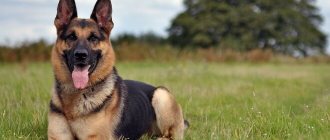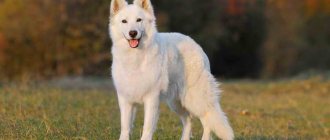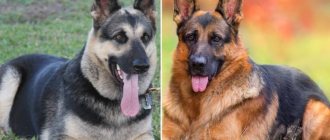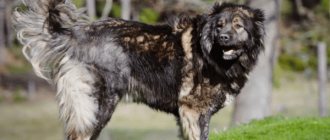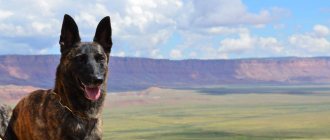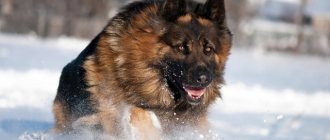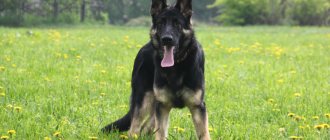History of the White Swiss Shepherd breed
White Swiss Shepherd
The beautiful legend that the White Swiss Shepherd breed appeared due to the artificial crossing of a shepherd with a white polar wolf is far from the truth, although the dog’s caution, its ability to move silently, and its agility, indeed, give reason to assume a relationship with the white-haired inhabitant of the Arctic. In fact, the breed was formed as a result of the systematic breeding of a certain type of German shepherd, which had a white color.
In the German canine literature of the end of the century before last, shepherd dogs, the ancestors of German shepherds, whose distinctive feature was white, were often described. And the first “delegate” from German shepherds, who participated in the Hanover Dog Show in 1882, was a white male, whom the owners named Greif. Later, his grandchildren and great-grandchildren, who also had a white color, were demonstrated at dog exhibitions and championships held in Germany. By the way, the German shepherd with the great name Horand von Grafrath, officially registered under the first number in the pedigree book of this breed in 1899, also belonged to the Greif family. However, the color of the famous dog was yellow-gray.
Already by the beginning of the twentieth century, the German Shepherd was not considered an ordinary herding breed. Such remarkable qualities as strength, endurance, extraordinary intelligence, good trainability, and loyalty have brought this dog extreme popularity not only in Europe, but also overseas. Selection work was carried out very actively, the requirements for its service qualities and exterior grew, but until a certain time, no importance was attached to color, and white individuals were bred in the same way as others, without singling out in any way.
However, in the 30s, in their native land, Germany, white German shepherds found themselves in disgrace. The Nazis, who rose to the heights of power, established their manic control over such an area of human interests as dog breeding. They found the white gene to be responsible for all the defects, defects, defects found in German shepherds. The verdict turned out to be “tenacious”, and even after the fall of the Hitler regime on the European continent, white shepherd dogs were rejected until the 60s.
White Swiss Shepherd puppy
Meanwhile, overseas, in the USA and Canada, breeders continued breeding white German Shepherds, proclaiming that “there is no bad color on a good dog.” Spectacular snow-white dogs became increasingly popular, often appearing on television and becoming pets of famous people, such as the Rockefellers.
Since the 60s, many North American kennel clubs began breeding white shepherds as the original breed, and over time their mating with shepherds of other colors was banned.
Over the next decade, the dogs, now called American-Canadian White Shepherds, began to return to Europe. The first of them settled in Switzerland, where the development of the breed continued. The status of the founder of the Swiss breeding line is given to the male Lobo, brought from the USA, born in 1966. He and his descendants are registered in the Swiss Stud Book (LOS). Over the next few decades, an impressive number of purebred white shepherd dogs spread across Europe, and in 2003, on the initiative of Switzerland, the American-Canadian white shepherd was accepted into its ranks by the international canine organization FCI, but it received a different species definition, namely, the white Swiss shepherd dog Around the same time, the breed began to gain popularity in Russia, but today it is not one of the most common.
Origin story
During the Enlightenment of the 18th century, the German states were covered by a wave of crimes, so the question arose of creating a special service dog to help the police.
One cynological community, Philax, has set itself the goal of developing a new breed from local herding shepherd dogs from different regions of Germany (Thuringia, Bavaria, Württemberg and Saxony).
Constantly subject to criticism about what the next breed should become in the final version, the community itself did not last long.
However, it still managed to leave important developments on white shepherds:
- drew attention to the value of many qualities inherent in herding dogs;
- developed a certain view on the required type of police service dog.
Smart pets with a snow-white color quickly won the hearts of private dog breeders. Rumors about the new breed quickly spread beyond the country, and puppies began to be sold to the UK, and from there to Canada and America.
NOTE!
The descendants of the German Shepherd carry the white gene in a latent state, so each subsequent mating in 90% of cases out of 100 will necessarily produce one or more puppies of the required shade in the litter.
Left without strict control from professional dog handlers, amateur breeders made every effort to breed shepherd dogs that are in greatest demand - light-haired ones.
Today, the white color, which almost destroyed the breed in Germany as a glitch in genetics, has become one of the reasons for its popularity. Fans of non-standard species get white shepherds primarily because of their unusual appearance and character inherent in a real working dog.
Appearance of a White Swiss Shepherd
The appearance of the powerful and muscular White Swiss Shepherd is similar to that of an ordinary German Shepherd. They are almost identical in height, but the “Swiss” is built a little denser. Among the representatives of the breed there are long-haired individuals and those with medium-length hair. The former are distributed mainly in Germany, Austria, France, and the latter in Holland and the North American continent.
Frame
White Swiss Shepherd admiring his native Alps
The dog has an elongated croup, slightly inclined towards the base of the tail, and a strong, straight back. The chest is powerful, of medium width, oval in shape, deep, reaching down to the elbows, its front part is expressive. The abdomen is moderately tucked. The sides and lower back are strong. The withers are clearly expressed.
Neck
Muscular, slightly elongated, no dewlap. The line of the neck, gently transitioning from the rather high-set head to the withers, is nobly curved.
Head
The head of the Swiss Shepherd is proportional to the body, has straight, clean lines, and is wedge-shaped when viewed from above and from behind. The line of transition from the forehead to the muzzle is smooth, but the very place where they connect is clearly distinguishable. The powerful muzzle is elongated, slightly tapering towards the nose. The nose itself is medium in size, the preferred color of the earlobe is black, but a simply dark color is also acceptable.
Jaws, teeth, lips
Beach party
The jaws are powerful, the teeth are located strictly perpendicular to them. Scissor bite. The lips are an intense black color and should be dry and pressed tightly together.
Ears
They stand straight, set high, slightly directed forward. Their shape is V-shaped, the tips are slightly rounded.
Eyes
Small, slightly slanting, almond-shaped, color - from brown to dark brown, a black rim is welcome.
Muzzle of a white Swiss Shepherd
Limbs
Kiyayaya
The forelimbs of the Swiss Shepherd are strong, lean, and their bones are not too heavy. When viewed from the front, they appear to be set quite wide apart. The shoulder and forearms are elongated, with powerful muscles. The pasterns are strong and set slightly obliquely.
The hind limbs are muscular. From behind they look straight and parallel. The thighs are of medium length and well-developed muscles. The shins, with solid bones, are also muscular. The hocks are of medium length, straight, lean.
The dog's paws are oval in shape, with the hind legs slightly longer than the front ones. The fingers are clenched tightly and almost curled into a ball. The pads are elastic, black. The same color is preferred for claws.
Movement
The White Swiss Shepherd moves powerfully, measuredly, consistently rearranging its limbs. The dog's lynx creeps, as if sneaking.
Tail
Running Swiss Shepherd
Richly covered with hair, has a saber shape. Set on quite high and reaching at least to the hock joint, tapering towards the end. When the dog is in a calm state, the tail hangs towards the floor, sometimes curving slightly in the lower third. In an animated animal, the tail rises vigorously, but does not exceed the top line.
Wool
The animal's coat is thick, tightly covering the body. Both dogs with medium-length hair and long-haired dogs have an abundant undercoat. The outer hair is straight and somewhat coarse. On the ears, muzzle, and forelimbs the hair is noticeably shorter than in the neck area and the back of the hind limbs. The neck of long-haired Swiss Shepherds is decorated with a spectacular mane, and their hind limbs are dressed in woolen “pants”. A slightly wavy coat is acceptable.
Color
Only solid white color is recognized.
Breed defects
- Light yellow or fawn tint of color (fawn) in the back area, at the base of the tail, at the tips of the ears.
- Fragmented lack of pigmentation on the nose, lips, and rims of the eyes.
- Shortened, square-shaped body.
- Drooping or semi-erect ears.
- A curled or looped tail, a hook-shaped tail, positioned above the line of the back.
- Lack of undercoat. Too soft, velvety coat, as well as curly coat.
- Bulging eyes. One or both eyes are blue.
- Excessive aggressiveness or, on the contrary, timidity, timidity.
Breed standards and description
Height at withers: males 63-66 cm, females 52-55 cm; Weight: 25-40 kg.
- Color: white;
- Coat: The standard allows long-haired and short-haired coat varieties;
- Eye color: brown, dark brown;
- Eye shape: almond-shaped;
- Nose: black;
- General appearance: muscular, proportionally built herding dog with strong strong paws, smooth body lines, saber-shaped tail.
Disqualifying faults:
- Shyness;
- Expressed aggression;
- Blue eye color;
- Protruding eyes;
- Malformations of the eyelids (entropy, ectropia);
- Malocclusion;
- Lack of pigmentation of the nose, lips, area around the eyes;
- Albinism.
Serious deficiencies that judges may classify as vices include:
- Square body profile;
- Irregular ear shape (dropping, wide-set, half-dropped);
- Ring-shaped tail (curled upward);
- Slanted back.
Photo of a white Swiss Shepherd
Personality of the White Swiss Shepherd
The White Swiss Shepherd is dynamic, temperamental, active and, at the same time, distinguished by its balance. Its character is softer and more reserved than that of the German Shepherd, but, despite its good nature, in the event of a threat to its owners and home, it displays the same qualities as its more aggressive relatives. In fact, white shepherds have all the character traits that a service dog has: strength, tirelessness, excellent reaction, intelligence. They are often used as guard dogs, rescue dogs, guide dogs, and bodyguards. Temperamental and cheerful, they are partial to sports, adventure, travel, and simply love to swim and play ball.
White Swiss Shepherd with his beloved owner
White Swiss Shepherd with cat
Affectionate and playful, White Swiss Shepherds get along well with all family members, including pets, including cats. They treat children very carefully, and perceive their pranks with condescending understanding. When interacting with babies and animals smaller than itself, the shepherd often displays herding instincts and begins to “herd” them, diligently and vigilantly taking care of them. Dogs of this breed prefer not to come into contact with strangers, they do not clearly express their wariness towards them, and they remain distinctly aloof.
Gentle White Swiss Shepherds really need the attention of their owners, their affection, they also love to “talk” and have a penchant for “vocal exercises”. It is worth noting that the range of their vocal signals is very wide, and sometimes they produce entire arias, the tonality and volume of which depends on their state of mind: these can be whimpers, grunts, moans or calls.
White Swiss Shepherd in a lavender field
Character and temperament
The Swiss White Shepherd is balanced, intelligent, and obedient. It is no coincidence that the breed is considered universal, because the Swiss work as guide dogs, rescuers, security guards, and shepherds.
Character virtues are obvious:
- The Shepherd never shows unmotivated aggression;
- Confidently protects the owner in the event of a real threat;
- Gets along well with children;
- She is rarely annoying and disobedient.
The disadvantages include the fact that Snow White gets too bored alone . The Swiss White Shepherd does not accept rough treatment and remembers the offender well, who will never win the dog’s trust. Features that others don’t like too much include a tendency to “vocal” - dogs often howl when left alone in the house.
Education and training
Raising and training Swiss Shepherds is a real pleasure. They understand and remember the owner’s commands instantly, and their lively intelligence and enthusiasm accelerate the acquisition of certain skills by the animals. Training requires consistency and consistency.
It is unacceptable to use brutal training methods in relation to white Swiss shepherds, and there is no need for this - the dogs are obedient from birth. Often the owners themselves do not want to scold and punish their pets, especially when they are at a tender age, representing cute snow-white angels. However, you should not forget that this is not a lapdog, but a future serious service dog in need of training.
It is important to remember that mistreatment and lack of socialization and training can cause aggression towards people and other animals. The owner of a White Swiss Shepherd will need calmness, consistency in actions and confidence in himself and his abilities.
Care and maintenance
Training a White Swiss Shepherd
Grooming a White Swiss Shepherd is not difficult. Even a dog’s thick coat, regardless of its length, can be kept in order without making excessive efforts. She will require special care during the molting period. During this time, the dog should be brushed at least twice a week, using sprays specially designed for removing hair. Short-haired animals are combed with a fine comb. It is advisable to first comb a long-haired pet with a sparse comb, then, if necessary, untangle or cut out tangles, then comb it with a fine-toothed comb, and finally treat it with a massage brush made of natural bristles. At the end of the procedure, it is advisable to run wet hands over the fur several times to remove any remaining dead or combed hairs.
Once a week, your pet will need to brush its teeth using a toothpaste designed for dogs. The movements should be sweeping - from the base of the teeth to their edges. It is advisable to wipe your eyes with a damp cloth every day; your ears can be cleaned twice a month with a regular cotton swab. Shepherd dogs' nails are trimmed, as a rule, once every month to a month and a half; a nail clipper is used for this purpose. If you are not used to this tool, you can injure your claws. We advise you to contact a specialist in the first months and observe the procedure.
Frequent bathing of a White Swiss Shepherd is not recommended, regardless of the color of its coat. Typically, general washing occurs twice a year. However, after a walk in bad weather, the dog’s paws and belly should definitely be washed; it is also necessary to clean the contaminated areas of its coat - this can be conveniently done with dry shampoo.
Will you play with us?
Shepherds need regular exercise and should be taken for walks at least three times a day. The dog will be delighted if, during a walk, he gets the opportunity to run after a ball or stick, swim, catch a flying disc, and frolic in the company of his fellow breeders.
The White Swiss Shepherd has a good appetite and is not picky about food. You can feed her both natural products and ready-made food. It is advisable to treat your pet at the same time. Two to four month old puppies are fed 4 times a day, and by the age of six months they gradually switch to two meals a day.
Most of the diet of a dog eating natural foods should be meat - lamb or beef. It can be given raw or scalded with boiling water. In small quantities, the Swiss Shepherd's menu should include steamed vegetables, porridge (rice, buckwheat, oatmeal - separately or assorted), low-fat cottage cheese and kefir, and sea fish. Twice a week you can offer your pet a boiled egg or a raw yolk. Beef liver is also a healthy food.
Dry food for a white Swiss shepherd needs to be selected. First, purchase a small bag of a specific food for this breed and check how much your pet likes it, and whether he has any allergies.
Health and Diseases of Swiss Shepherds
As has long been known, the white color of a dog does not at all mean that it is characterized by physiological pathologies. The White Swiss Shepherd, like the German one, is a very strong animal, characterized by good health. However, hereditary diseases are the same as those of her closest relatives, although such a common defect among the “Germans” as hip dysplasia is much less common among the “Swiss”. Other diseases common to breeds include:
- eosinophilic panostitis - colloquially a growth disease, expressed in lameness and characteristic of animals 5-12 months old;
- paresis of the pelvic limbs, manifested in limited motor ability;
- intussusception is one of the forms of intestinal obstruction;
- congenital heart failure.
Shepherds also have a predisposition to diabetes and various types of allergic reactions.
I got a little dirty here
BShO puppy with mom
Marriage or breed?
The dogs, known since 1882, gained recognition among dog breeders only at the beginning of the 21st century.
In the Fédération Cynologique Internationale (FCI), the white German breed was admitted for registration only in 2002, under standard number 347, in Section I of the “Shepherd Dog”, as a herding and service dog. Although this albino has nothing to do with the real Swiss Shepherd - the Sennenhund (Schweizer Sennenhund) and all its types.
Initially, the white gene was recognized as a defect, and all representatives of this breed were mercilessly culled, which led to their almost complete disappearance. But this applied exclusively to kennel clubs that adhered to German standards.
But in the USA, by that time the dog had already established itself as an independent breed and received a new name - “American-Canadian White Shepherd”. From abroad they were reintroduced to Europe, where they received a chance for renewed popularity. And although the breed is officially recognized by the International Cynological Federation, due to the fact that the United States is not a member of it, the name of the breed was changed in accordance with the norms of the federation.
Expert opinion
Kozhevin Semyon Kirillovich
Expert dog handler.
As experts note, the white shepherd is much softer and more gentle than the classic “Germans”.
But they still have the same hereditary diseases as their direct relatives:
- deafness from birth;
- dysplasia;
- heart defects;
- mental instability (aggression, hyperactivity, phlegmatic or fearful).
If the well-known standard is vigilant and tough, then the albino is more likely a pet that does not need these traits.
In addition to their spectacular color, their anatomy is striking - the white twins did not inherit the fashion for sloping croup, triangular formats and the ensuing problems with anatomy. They have retained an excellent body structure and have a calmer and more balanced temperament.
In addition, these dogs were not affected by problems with the hind limbs and back.
How to choose a puppy
The White Swiss Shepherd is a young breed and is not yet very popular in Russia. Many dishonest breeders take advantage of this and sell white puppies of unknown origin under the guise of white shepherd dogs. To buy a purebred cub of this breed, you need to contact specialized nurseries, which are found in almost all Russian cities with a population of over a million. They will be able to provide you with documents indicating the dog’s pedigree.
A healthy puppy should demonstrate activity, have shiny fur, curious eyes, and no discharge in the ears and corners of the eyes. Pay attention to eye color. They should be brown, not blue. Excessive thinness or a bloated tummy is a reason to be wary. Feel free to ask the White Swiss Shepherd breeder any questions - a professional who loves his job will answer each of them with enthusiasm.
Ask for test results from your future pet's parents for genetic diseases, particularly hip dysplasia. It would also be useful to observe the behavior of the puppy’s mother, who, as a rule, is with him in the kennel. The dog is unlikely to show affection towards you, but it should behave with restraint, showing neither aggression nor fearfulness.
Health
On average, white shepherds can live 11-15 years.
Nature has awarded the shepherd with good health, but not everything depends on natural data. The owner must take care of the pet and monitor its condition. Only in this case can the dog live the maximum number of years.
The dog owner's responsibilities include:
- Annual visit to the veterinary clinic for preventive examinations.
- Deworming.
- Carrying out routine vaccination.
- Regular treatment with drugs against skin parasites.
Every dog owner should be aware of their pet's predisposition to certain diseases. Below are the diseases that are most often observed in white shepherds:
1. Dysplasia of the elbow and hip joints - characterized by pain and lameness in the initial stages, at the last stage the dog faces complete or partial immobility with unbearable pain. 2. Allergies – an allergic reaction to food most often occurs; there may also be an allergy to fleas and care products. 3. Congenital diseases of the spine are abnormalities in the development of the number or structure of vertebrae (scoliosis, lordosis, kyphosis).
4.
Autoimmune diseases are an attack of the immune system against the organs and tissues of the body’s own, resulting in their structural and functional damage. 5. Exocrine pancreatic insufficiency - can develop at any age, but more often in individuals under 4 years of age. 6. Osteoarthritis – leads to abnormal development of the hip joint, damage to the cruciate ligaments, knee dislocation and joint damage. 7. Von Willebrand disease is a hereditary blood disorder. 8. Cauda equina syndrome is a serious neurological disorder. 9. Degenerative myelopathy - caused by impaired conduction of motor neurons in the spinal cord.
Photos of White Swiss Shepherd puppies
How much does a White Swiss Shepherd cost?
The cost of a White Swiss Shepherd puppy depends on what class of pet you are interested in.
Thoroughbred babies with a pet-class pedigree, aspiring only to become pets, can cost from 25,000 to 35,000 rubles in different cities of Russia. For a breed-class Swiss shepherd that can be used for breeding, you will have to pay from 30,000 to 40,000 rubles. The most expensive ones are show-class “Swiss” ones, which have an exhibition perspective. They cost from 40,000 rubles and above. A puppy without a pedigree can be purchased for 15,000 rubles.
